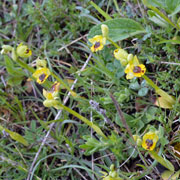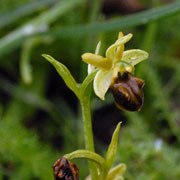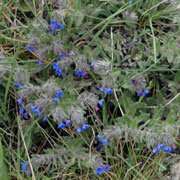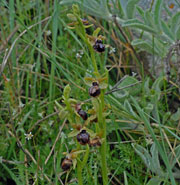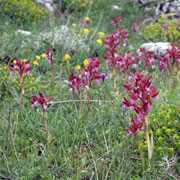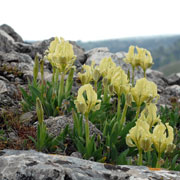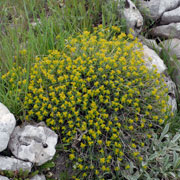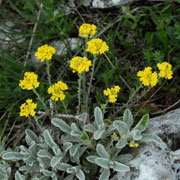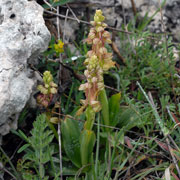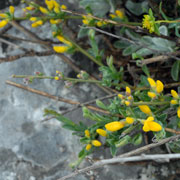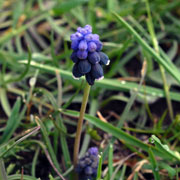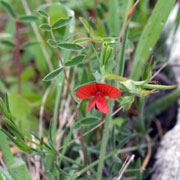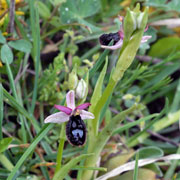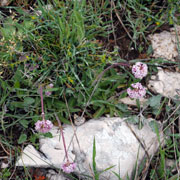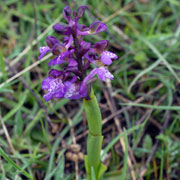This was the first time that my wife and I had booked a holiday with experienced guides to the natural history of a part of Europe. Normally we choose a place, find local walks and look at whatever we find without seeking rarities or special concentrations of flowers. The attraction of this tour was that the guides would not only know where to go but would probably know the names of the butterflies, birds and flowers we saw. Also Italy is famous for sunshine and good food. Spring flowers, good food, sunshine and the company of like-minded people. What could be better?
Part of the Italian commune of Puglia consists of the Gargano peninsula, a huge limestone (dolomite) lump sticking into the Adriatic. On the map it looks like a spur on the boot of Italy. The Gargano is famous for its flower meadows and scenery and quite a few of the Nature tour operators send parties here during the Spring. Even if there's a break in the weather you can still look forward to some excellent meals in the company of people who share your interests. That's the theory anyway.
We drew a fairly short straw. The guides were excellent, the flowers were amazing but during the entire week it was mostly cold. There were overcast skies, some rain and very little sunshine. Except for the last day we didn't once wake to a glorious Mediterranean morning and the estimated sunshine we enjoyed for the main days of the holiday totalled 5 hours at most. In fact the only time we reached for the sun hats and worried about over-exposure to U. V. was at a service station one hour from Bari airport as we prepared to leave Italy.
Most of our stay was in the village of in Monte St Angelo high up in the hills overlooking Manfredonia and had been arranged for convenient access to the rich flower meadows which surround it. We soon discovered that we were the only guests at this Hotel for most of the time and that the chef, assuming they once had one, had long since fled, taking his recipes with him. Our daily exchanges with our hosts were always pleasant and courteous but understandably this far south in the Italian countryside, they spoke little English. Fortunately a couple of our party including one of the leaders could make themselves understood in Italian and so communication wasn't quite in the hand gestures, shouts, and grunts which sometimes accompany the British in foreign lands.
Sunday Morning 19th April 2009 Monte St Angelo Stop 1
Our first foray was local. Only a hundred or so metres from the Hotel was a hillside with several species of Orchid. In fact there were so many orchids here that we were constantly warning each other not to step sideways or backwards onto yet another patch. Within the first ten minutes of the first day we had found the Ophrys garganica (Gargano Ophrys) which sounds endemic but actually isn't, being found in several other places in the Mediterranean. Nearby the Dark Ophrys (Ophrys incubacea) was growing and we were shown the characteristics of both: O. garganica has distinctly wavy upright petals while the lower petal in Ophrys incubacea has hairy lumps on either side of the lower petal (labellum) looking like shoulder pads.
There were Ophrys lutea (Yellow Orchid) species nearby too. The Ophrys lutea group contains several plants which are each a little bit different from each other but require careful examination to be sure. People who happily give whole species status to each plant in such a group like this will call each one a different name such as Ophrys sicula. Botanists who prefer this way of naming plants are known amongst botanists as Splitters. Those who give them names like Ophrys lutea ssp sicula where each member is a sub species (ssp) of the main Ophrys lutea are Lumpers. So we saw Ophrys lutea ssp sicula rather than Ophrys sicula depending in which camp you belong and we were shown the small differences between Ophrys lutea ssp sicula and the nearby Ophrys lutea ssp lutea. Just to confuse those who dislike systematic names anyway and prefer the more straightforward English ones, each of these different plants, regardless of lumping or splitting, is called Yellow Orchid. That's a good explanation why we need precise naming of course. The common names don't differentiate between sub species.
Clear?
Thought not.
In between discussing names, photographing the plants or just admiring the clumps of Orchids, we saw the deep blue flowers of Alkanna lehmanii (Dyer's Alkanet) - and just in case you weren't completely confused about the naming of stuff, there's more than one plant in this genus which is known as Dyer's Alkanet. Alkanna lehmanii is a prostrate blue plant which will grow equally well in the hills as by the coast and we saw this one on many occasions including later on right by the seaside.
Nearby on the hillside there were domes of a greeny-yellow plant which reminded me of the much larger Euphorbia dendroides cushions by the garigue coast of Gozo (one of the Maltese Islands). These plants were much smaller but were indeed members of the Euphorbia genus. It was Euphorbia spinosa which doesn't have an English name but is a Spurge. Not having an English name is quite common for non-British plants which are not thought to be useful for anything either in the kitchen or as a herbal remedy. Sometimes there is a local name which can be translated into English. Not even that applies here for the common Italian name is Euforbia spinosa.
On the upper reaches of this hillside we saw for the first time one of the eye catching sights of the holiday: Orchis papilionacea (The Pink Butterfly Orchid). This plant will often grown in swathes of twenty, thirty or even more and the contrast of its flowers with the green of the pasture was always striking. In this photograph it there were fifty or so plants growing among the yellowy green clumps of Euphorbia spinosa. It's hard to describe the floral diversity of these meadows but whether you knew the names or not there were yellows, blues, pinks, browns amongst the different flowers we saw making the whole area an impressive sight. The orchids which attract so much attention were very interesting to study and photograph but in my opinion the other plants were more pleasing to the eye. Still there were several species of orchid in these meadows so close to our Hotel and in such large numbers that the possibility of hybridisation between species was greatly increased. And during our stay we found several hybrid orchids too.
Though many of the Ophrys genus are intriguing in the their apparent mimicry of insects, they can often be quite dark overall and not easy to find in a green meadow full of other distractions. There's no mistaking the Pink Butterfly Orchid though which demands admiration. On the other side of the road a low stone building for sheltering sheep was covered in a small pale yellow iris Iris pseudopumila (Dwarf Iris) and with the bay of Manfredonia barely discernible through the misty gloom in the background. It made a splendid photograph.
Other plants we saw in this first meadow included Alyssum saxatile (Yellow Alyssum) the golden yellow plant so often found in gardens in Britain and which has occasionally escaped into the wild in England and Wales. Aceras (Orchis) anthropophorum (Man Orchid) was quite common in the Gargano and this is another plant which although uncommon, also grows in the British Isles. The first endemic plant we saw was a prostrate broom Cytisus decumbens ssp elata (No English name) but the nearby small dark Muscari neglectum (Grape Hyacinth) an be found in East Anglia in the British Isles. Hidden in the grass was the small Red Vetchling Lathyrus cicera, another insect mimicking orchid Ophrys bertolonii (Bertoloni's Orchid), a very soggy small Valerian named Valeriana tuberosa and a familiar Orchid from back home Orchis morio (Green-winged Orchid). Orchis morio was one of the commonest we saw on this visit to Italy. In many of these photos drops of water and glistening patches of wet are the signs of the cold damp and very un-Italian weather conditions.


